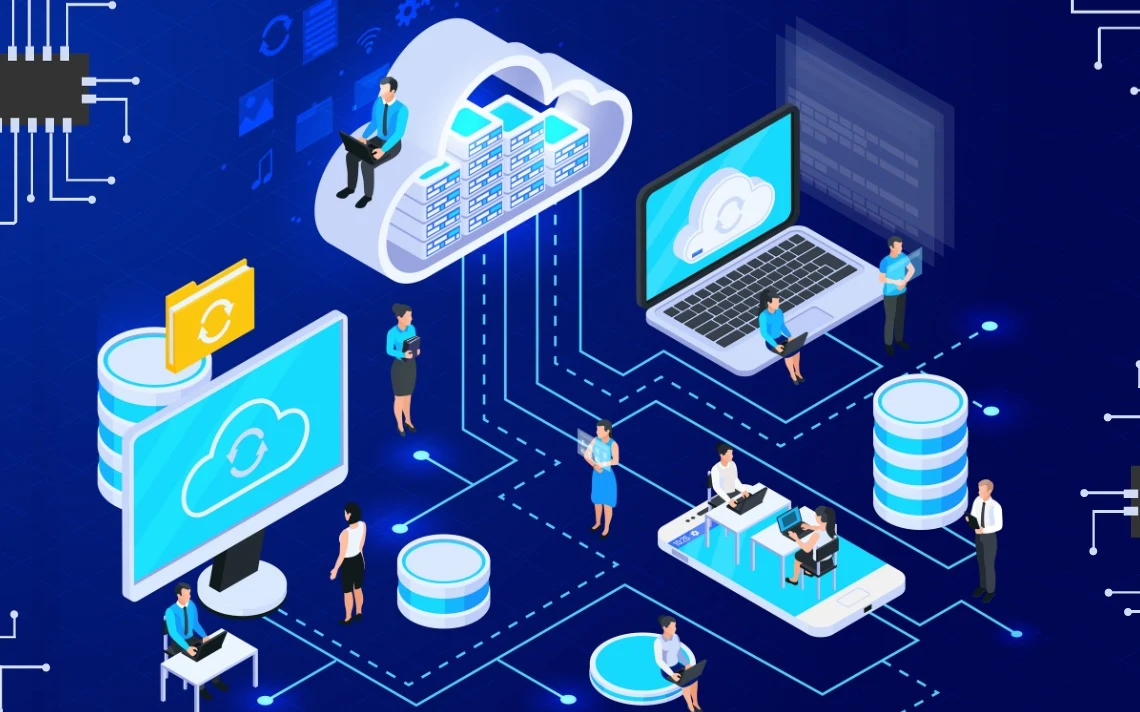In the constantly changing realm of contemporary business, organizations face a crucial decision between Cloud-based and On-Premise Enterprise Resource Planning (ERP) solutions. This choice is pivotal for those aiming at enhanced efficiency, scalability, and adaptability. As businesses traverse the intricate path of digital transformation, comprehending the intricacies of Cloud and On-Premise ERP systems becomes paramount. This blog seeks to serve as your compass, offering insights to empower you in making well-informed decisions that align with the distinctive needs and future goals of your organization.
Cloud ERP – A Proven Choice:
The domain of Cloud ERP systems has evolved into a hub of technological progress, presenting businesses with a verified and effective solution for overseeing their vital processes. The inherent agility and flexibility of Cloud ERP position it as a compelling option for organizations spanning diverse industries.
One of the primary merits of Cloud ERP is its accessibility. Harnessing the capabilities of the cloud empowers businesses to reach their ERP systems at any time and from any location, fostering a collaborative and responsive work environment. This accessibility transcends geographical constraints, enabling teams to seamlessly collaborate, even in a globally distributed setup.
Scalability stands out as another defining feature of Cloud ERP. As businesses undergo growth and transformation, their ERP requirements undergo corresponding changes. Cloud solutions are meticulously crafted to scale effortlessly, accommodating heightened data loads, increased user numbers, and expanded functionalities without necessitating substantial infrastructure investments. This adaptability proves especially advantageous for organizations undergoing dynamic expansion or operating in industries marked by seasonal fluctuations.
A crucial driver drawing businesses towards Cloud ERP is its cost-efficiency. The transition from traditional on-premise solutions to a pay-as-you-go model enables organizations to fine-tune their expenditures. Instead of hefty initial investments, businesses can allocate resources judiciously, paying only for the services they utilize as they scale. This financial flexibility represents a game-changing aspect, particularly for small to medium-sized enterprises aspiring to compete at a higher echelon without exceeding budgetary constraints.
As we delve into the merits of Cloud ERP, it becomes apparent that this approach transcends being a mere trend; it stands as a validated choice, offering tangible benefits for organizations willing to embrace the future of enterprise management.
On-Premise ERP – The Alternate Approach:
In the recent past, On-Premise ERP systems held an unquestionable position as champions of enterprise resource management. Serving as pioneers in the era of digital transformation, these systems were synonymous with business operations, serving as the robust backbone of organizational data management.
In the late 20th century and the early 2000s, On-Premise ERP solutions enjoyed unrivaled supremacy. Companies invested substantially in establishing in-house data centers and infrastructure to host their ERP systems. This method instilled a sense of control and security, providing organizations with direct oversight of their servers and databases. Unlike cloud ERP, where
data centers are not specific to a particular customer, On-Premise ERP clients have a local server with a database within the customer’s control or office premises where business is run. Cloud vendors like Oracle, Amazon, Microsoft maintain data centers that are customer-agnostic, built based on geographical needs such as country or regions. For example, Oracle has established data centers in India and the Middle East, serving the needs of multiple customers in those regions. This fundamental difference underscores the level of control and customization offered by On-Premise ERP compared to the more geographically dispersed and shared infrastructure of Cloud ERP.
The dominance of On-Premise ERP became deeply rooted in the traditional mindset of business leaders who valued tangible control over their technological assets. However, as technology underwent rapid evolution, the landscape began to shift, giving rise to the emergence of Cloud ERP solutions.
Despite the transformative impact of Cloud ERP, On-Premise solutions continue to occupy a significant niche, especially in industries with rigorous regulatory demands. Sectors such as healthcare, finance, and government, where data privacy and compliance are non-negotiable, often favor On-Premise ERP.
In these settings, maintaining absolute control over sensitive data is paramount. On-Premise ERP provides a dedicated infrastructure, enabling organizations to customize security measures to align with specific regulatory standards. This level of control is particularly crucial when handling confidential patient information, financial transactions, or classified government data.
Moreover, On-Premise ERP excels in scenarios where connectivity poses a challenge. In industries with remote operations or locations featuring limited internet access, relying on a locally hosted ERP system ensures consistent performance and data availability. This mitigates the risks associated with dependence on external network infrastructure.
As we delve into the alternative approach of On-Premise ERP, it becomes evident that, despite the shift in dominance with the ascent of cloud solutions, there are distinct scenarios where the traditional, in-house model remains a robust choice. It provides unparalleled control and compliance, particularly for organizations navigating complex regulatory landscapes.
Key Considerations for Businesses:
When standing at the crossroads of ERP decision-making, businesses must carefully weigh a myriad of factors, each playing a pivotal role in shaping the future trajectory of their operations. Navigating this intricate landscape requires a nuanced understanding of the following critical considerations:
- Data Security: In an era marked by escalating cyber threats, safeguarding sensitive information is paramount. Organizations operating in industries like finance or healthcare, where data breaches can have severe consequences, prioritize On-Premise ERP for its localized control and customizable security measures.
- Flexibility: The ability to adapt swiftly to evolving business needs is fundamental for long-term success. Cloud ERP shines in industries with dynamic growth, allowing organizations to scale resources effortlessly.
- Cost Considerations: Balancing the books is essential for sustainable growth, making cost-efficiency a critical factor. Small to medium-sized enterprises often find the pay-as-you-go model of Cloud ERP appealing, eliminating the need for substantial upfront investments.
- Scalability: The ability to grow without hindrance ensures that ERP systems align with the organization’s expansion. On-Premise ERP can pose challenges for rapidly growing businesses, while Cloud ERP’s scalability accommodates increasing data loads seamlessly.
- Customization: Tailoring ERP systems to specific business processes enhances operational efficiency. On-Premise ERP is favored when intricate customization is crucial, addressing unique industry requirements.
As businesses embark on the ERP journey, these considerations serve as the compass, guiding organizations towards solutions that not only meet their current needs but also position them for sustainable growth and resilience in the face of evolving industry landscapes.
The Shifting ERP Landscape:
In the dynamic realm of Enterprise Resource Planning (ERP), the seismic shift brought about by the advent of cloud technology has not merely been a technological evolution; it has fundamentally reshaped the roles, responsibilities, and financial structures underpinning ERP implementation.
The rise of cloud technology has democratized access to advanced ERP capabilities, dismantling traditional barriers and ushering in an era of unprecedented accessibility. ERP systems, once confined to on-premise infrastructures, have now transcended physical boundaries, providing organizations with the agility needed to thrive in an ever-changing business landscape. This evolution is marked by:
- Enhanced Collaboration: Cloud ERP fosters seamless collaboration by providing real-time data access to stakeholders across the organization. This shift has dismantled silos, enabling departments to work cohesively and make data-driven decisions collectively.
- Remote Accessibility: With the cloud, ERP systems are no longer tethered to office servers. Remote access has become a norm, empowering teams to work from any location, fostering flexibility in work arrangements.
As the ERP landscape undergoes this transformation, traditional job roles within IT teams, consulting firms, and vendor organizations are being redefined:
- IT Teams: Cloud ERP has recalibrated the role of IT teams from infrastructure management to strategic enablers. Instead of dedicating resources to server maintenance, IT teams are now focusing on optimizing processes, ensuring data security, and leveraging cloud-native features.
- Consultants: ERP consultants are evolving into strategic advisors, guiding businesses on how to leverage cloud technology for maximum impact. Their expertise is not only technical but extends to aligning ERP solutions with overall business objectives.
- Vendors: Cloud ERP has redefined the vendor-client relationship. Vendors are no longer just providers of software; they are partners in innovation. Continuous updates, maintenance, and support are inherent in the subscription-based model, fostering long-term collaboration.
The traditional upfront capital expenditure (CapEx) model, synonymous with on-premise ERP solutions, is making way for the subscription-based operational expenditure (OpEx) model associated with cloud solutions:
- Financial Flexibility: The OpEx model allows businesses to allocate costs more flexibly, paying for services as they use them. This shift eliminates the need for large initial investments, democratizing access to advanced ERP solutions.
- Continuous Innovation: Subscription-based pricing ensures that businesses are continually benefiting from the latest features and updates. This approach aligns ERP solutions with the pace of technological evolution, providing organizations with a competitive edge.
As the ERP landscape continues its metamorphosis under the influence of cloud technology, organizations, IT professionals, consultants, and vendors must not only embrace technological change but also adapt their roles and financial strategies to thrive in this dynamic new era.
Case Studies and Success Stories:
- Successful Transitions to Cloud ERP: In the retail sector, Amazon, grappling with scalability and operational inefficiencies due to outdated systems, made a strategic move towards Cloud ERP. The transformation streamlined their operations, providing real-time insights across the organization. As a result, Amazon witnessed a remarkable 30% increase in overall efficiency and successfully expanded into new markets, showcasing the power of Cloud ERP in fostering growth and agility.Similarly, Tesla, facing prolonged product development cycles, recognized the need for innovation. By embracing Cloud ERP, they introduced real-time collaboration and streamlined processes. This shift resulted in a 40% reduction in time-to-market and a significant 25% boost in product innovation, illustrating how Cloud ERP can revolutionize production processes and drive innovation.
- Thriving On-Premise Solutions: In the public sector, NASA, dealing with strict compliance requirements, opted for On-Premise ERP to address their unique regulatory challenges. The decision allowed for highly tailored solutions, enabling NASA to maintain a decade of regulatory excellence with zero penalties. This case highlights the resilience and adaptability of On-Premise ERP in meeting specific industry compliance standards. Similarly, Mayo Clinic, prioritizing data security and compliance in a highly regulated industry, continued with On-Premise ERP. Their commitment to maintaining complete control over sensitive patient information resulted in an impeccable record of zero data breaches. This case emphasizes how On-Premise ERP can provide a secure and compliant environment for industries dealing with sensitive information.
Oracle’s De-Support Date
The looming de-support date set by Oracle for their on-premise ERP systems, scheduled for as early as 2035, casts a significant shadow over businesses still reliant on these legacy solutions. The implications of this impending deadline are multifaceted and demand proactive measures from organizations:
Implications:
- Security Risks: With the cessation of Oracle’s support, businesses face heightened security risks. Without regular updates and patches, vulnerabilities may go unaddressed, leaving systems exposed to potential cyber threats.
- Compliance Challenges: Industries with strict regulatory frameworks may find themselves in non-compliance post said de-support, risking penalties and reputational damage.
- Stagnation of Technology: As the broader technological landscape evolves, on-premise systems will become increasingly outdated. This stagnation could hinder business agility, innovation, and competitiveness.
Preparing for the Transition: To navigate this challenging transition, businesses should adopt a proactive stance:
- Conduct a Comprehensive Assessment: Evaluate the current state of your on-premise ERP system, identifying dependencies, critical functionalities, and potential areas of risk.
- Explore Migration Options: Consider migrating to a Cloud ERP solution. Evaluate providers, ensuring they align with your business needs and offer robust support and security features.
- Develop a Transition Roadmap: Create a detailed plan outlining the steps involved in the migration process. Establish timelines, allocate resources, and communicate transparently with stakeholders.
- Data Migration and Training: Execute a meticulous data migration strategy to ensure a seamless transition. Additionally, invest in comprehensive training programs for employees to adapt to the new system effectively.
- Engage with Experts: Collaborate with ERP consultants who specialize in migrations. Their expertise can prove invaluable in navigating complexities and ensuring a successful transition.
As the ERP landscape undergoes unprecedented transformations, businesses must remain vigilant, recognizing that one size does not fit all in the realm of ERP solutions. Tailoring choices to the unique needs of each business is not just a recommendation but a strategic imperative for sustained
In this era of technological dynamism, the choices we make today shape the possibilities of tomorrow. How will your ERP choice propel your business towards innovation and resilience in the face of an ever-evolving digital landscape?




